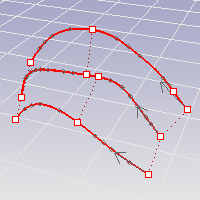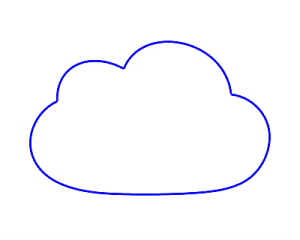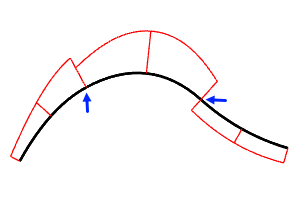Rebuild
| Toolbar | Menu |
|---|---|
|
|
Edit Rebuild |
The Rebuild command reconstructs selected curves or surfaces to a specified degree and control point number.
Steps
-
Select the curves or surfaces.
Or, press Ctrl (CMD) + Shift to select a polycurve segment.
Curves and extrusion objects
To rebuild curves
- Click Preview to see what the rebuilt curves will look like.
- When you are satisfied with the results, click OK.
Note
- Turn on control points and curvature graph to see the details of the curve structure.
- A group of curves will be rebuilt with curves of a specified degree and specified number of control points. The knot of the resulting curve more evenly spaced. To rebuild a curve with uneven knot spacing but a more accurate fit, use the FitCrv command.
Rebuild options
Point count
Reports in parentheses the current number and sets the number of control points in the result.
Degree
Reports in parentheses the current number and sets the degree of the curve. Degree in Rhino can be up to 11.
Point count and Degree values change automatically to fulfill the minimum requirement of Point count = Degree + 1. For example, when Point count=4 and Degree=3, reducing Point count also reduces Degree; increasing Degree also increases Point count. In closed curves/surfaces, the start and end points are overlapped and counted as one. They have one less point than open curves/surfaces.
 Delete Input
Delete Input
Deletes the original geometry.
History is supported when Delete Input is unchecked.
 Create new object on current layer
Create new object on current layer
Creates the new objects on the current layer. Clear this check box to place the new objects on the layer of the original curves.
 Preserve end tangent directions
Preserve end tangent directions
The new curve matches the input curve end tangents if the curve is open, the degree is two or more, and the point count is four or more.
 Make SubD friendly
Make SubD friendly
Makes the output curve compatible with SubD. Details...
When this option is enabled, the Degree option is disabled. The output curve can only be degree 3.
Rebuild a curve to match another curve's parameter structure.
The Loft, Sweep1 and Sweep2 commands create a better surface from section curves with the same parameter structure.
Span counts
Reports in parentheses the minimum number of spans and the proposed number of spans.
Maximum deviation
Reports the maximum deviation from the original curve when Preview is clicked.
Displays a preview of the output.
If you change the settings, click the button again to refresh the display.
To access hidden command-line options
- Type a hyphen in front of the command name: -Rebuild.
| Command-line options | |
|---|---|
|
Type subcrv to select part of a curve as input. |
|
Surfaces
To rebuild surfaces
- Click Preview to see what the rebuilt surfaces will look like.
- When you are satisfied with the results, click OK.
Rebuild Surface Options
Point count
U
Reports in parentheses the current number and sets the number of points in the u direction.
V
Reports in parentheses the current number and sets the number of points in the v direction.
Degree
U
Reports in parentheses the current number and sets the degree in the u direction.
V
Reports in parentheses the current number and sets the degree in the v direction.
Point count and Degree values change automatically to fulfill the minimum requirement of Point count = Degree + 1. For example, when Point count=4 and Degree=3, reducing Point count also reduces Degree; increasing Degree also increases Point count. In closed curves/surfaces, the start and end points are overlapped and counted as one. They have one less point than open curves/surfaces.
Options
 DeleteInput
DeleteInput
Deletes the original geometry.
 Current Layer
Current Layer
Creates the new surfaces on the current layer. Clear this checkbox to place the new surfaces on the layer of the original surfaces.
 Retrim
Retrim
Trims the rebuilt surface with the original trimming curves.
Span counts
U
Reports in parentheses the minimum number of spans and the proposed number of spans in the u direction.
V
Reports in parentheses the minimum number of spans and the proposed number of spans in the v direction.
Maximum deviation
Reports the maximum deviation from the original surface.
The calculation tests how far away the new surface is at knot line intersections and half-way between knot lines. Conducts tests at knot line intersections and halfway between knot lines.
The display color indicates how far away the new surface is from the original. Points are green if the surface is within absolute tolerance, yellow if it is between tolerance and 10 times tolerance, and red if it is farther away than that.
Displays a preview of the output.
If you change the settings, click the button again to refresh the display.
| Toolbar | Menu |
|---|---|
|
|
|
The RebuildUV command reconstructs selected surfaces to degree 3, with a specified control point number, in either the u or v direction. The surface structure in the other direction is left unchanged.
Steps
- Select surfaces to rebuild.
| Command-line options | |
|---|---|
|
Direction |
Specify the u, v, or both directions. |
|
PointCount |
Specifies the number of control points in the result. |
|
Type |
LooseThe surface control points are created at the same locations as the control points of the original. This is a good option if the control points will be edited later. NormalThe surface has an average amount of stretching between the curves. This is a good choice when the curves are proceeding in a relatively straight path or there is a lot of space between the curves. Straight sectionsCreates a ruled surface. The sections between the curves are straight. TightThe surface closely follows the original. This is a good choice when the input curves are going around a corner. UniformMakes the object knot vectors uniform. |
|
DeleteInput |
YesDeletes the original geometry. NoRetains the original geometry. |
|
CurrentLayer |
The output will be on the current layer. |
|
Trims the rebuilt surface with the original trimming curves. |
|
| Toolbar | Menu |
|---|---|
|
|
|
The RebuildCrvNonUniform command interactively modifies selected curves by non-uniformly re-spacing the control points.
Steps
- Select the curves.

- Drag the points on the curves.
- Click the direction arrows to reverse the curve direction.
| Command-line options | |
|---|---|
|
RequestedTolerance |
Specifies the maximum distance the rebuilt curves can deviate from the originals. If you do not provide enough control points, the rebuilt curves may deviate more than RequestedTolerance from the originals. The maximum deviation from the original curves is reported at the command line and marked with a point on the curve. |
|
MaxPointCount |
Specifies the maximum number of control points per curve used to rebuild. |
|
Quarters |
Displays two more controls along each curve to influence how the RebuildCrvNonUniform command distributes control points. The controls at the end of the curves can be used to shorten the resulting curves. |
|
DeleteInput |
YesDeletes the original geometry. NoRetains the original geometry. |
|
ResetPoints |
Resets the editing points to their original locations. |
|
Type subcrv to select part of a curve as input. |
|
|
Toolbar |
Menu |
|---|---|
|
|
The Elmo command rebuilds curves with more customizable options.

Command-line options
PointCount
Number of control points in the rebuilt curve.
VariablePointCount
Rebuilds curves with various numbers of control points that produce the smallest separation.
Minimum/Maximum
The lowest/highest number of control points allowed for the rebuilt curve.
Degree (1~11)
Degree of the rebuilt curve.
TangentMatch (No/Start/End/Both)
Controls whether the tangent direction at the start, end, or both ends of the input curve is maintained. Choose No to ignore the tangent direction at both ends.
SubDFriendly
Makes the resulting curve compatible with SubD.
Smoothing (None/Low/Medium/High/Custom)
Controls the smoothness of the resulting curve.
-
The smoothing value can be set to 0 (None), 0.01 (Low), 0.1 (Medium), 1 (High), or a custom value between 0 and 10.
-
Higher values result in greater deviation from the input curve.
Uniformity (None/Low/Medium/High/Custom)
Controls how evenly the control points are spaced along the rebuilt curve.
-
The Uniformity value can be set to 0 (None), 0.01 (Low), 0.1 (Medium), 1 (High), or a custom value between 0 and 10.
-
Higher values result in more even spacing between control points.
KinkSplit
Controls whether to split the kinks of polycurves. This option is only available for polycurves or curves with discontinuous curvature.
KinkAngle
The minimum angle (in degrees) between adjacent curve segments to be considered a kink. Curve segments that exceed this angle are split at the kink.
SplitAtCurvatureChanges
Splits curves at locations where the curvature are not continuous, even if they are not sharp kinks

See Also
Rebuild
Reconstruct curves, surfaces, and extrusion objects to a specified degree and control point number.

